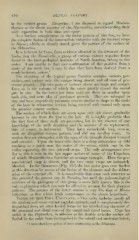Page 466 - My FlipBook
P. 466
DENTAL ANATOMY.
4 7(5
in the extinct genus. Altogether, I am disposed to regard llenisco-
therium as the direct ancestor of the Hyracoidca, notwithstanding their
wide separation in both time and space.
As a further complication in the molar pattern of this line, we have
the complete fusion of the intermediate tubercles with the internal cusps
in Hijra.v, which, as already stated, gives the pattern of the molars of
the rhinoceros.
It is believed by Cope, from evidence aifbrded by the structure of the
limbs, that the Toxodontia, a group of curious extinct ungulate forms
found in the later geological horizons of kSouth America, belong to this
order. I am unable to find any confirmation of this position from a
study of the teeth, but it may be that they have been derived from a
condvlarthrous source.^
The dentition of the typical genus Toxodon contains incisors, pre-
molars, and molars only, the canines being absent, and all were of per-
sistent growtii. The two pairs of incisors above are large and scalpri-
form, as in the rodents, of which the outer greatly exceed the mesial
pair in size. In the lower jaw these teeth are three in number upon
each side, and were also of persistent growth. They are subequal in
size, and have imperfectly prismatic crowns similar in shape to the tusks
of the boar in transverse section, being covered with enamel only upon
the anterior convex surface.
The molars, of which there are seven upon each side above, gradually
increase in size fr(^m the first to the last. It is highly probable that
the first four of these teeth are premolars, but in the absence of any
knowledge of the milk dentition and the manner of its replacement,
this, of course, is inferential. They have remarkably long crowns,
with an altogether unique pattern, and did not develop roots. In
section thevare triangular, with the apex of the triangle directed forward
and outward. Upon the inner side there is a deep indentation or fold
reaching to a point near the centre of the crown, which may be the
valley separating the two internal cusps. The only arrangement sim-
ilar to this is seen in the last upper molars of many of the Ungulata,
of which ]\[(nmcothennm furnishes an average example. Here the pos-
tero-internal cusp is absent, and the two outer cusps are intimately
blended. In the rhinoceros (Fig. 257) the last molar goes even further
in this direction by reason of the fusion of the elements and the obliter-
ation of the external rib. It is conceivable that some such structure as
this preceded the present one in Toxodoyi, but until the palseontological
evidence of the philogcny of this group is more fully known this is the
onlv explanation \\hicli can now be offered to account for their aberrant
pattern. The ])attern of the lower molars is very like that of Menis-
cotherium—a fiict wliich lends countenance to the above hypothesis.
Teeth of the True Ungut.ata.—This order includes nearly all
the modern and many extinct ungulate animals, and is conspicuously dis-
tinguished from all other hoofed forms by the interlocking character of
the proximal and distal rows of the carj)al and tarsal bones. Cope has
called it the Diplarflirn, in allusion to the double articular surface af-
forded bv the ankle-bone (astragalus) to the cuboid and navicular below,
'I have elsewhere spoken of tlieir relutionsliip to the Tillodontia.


